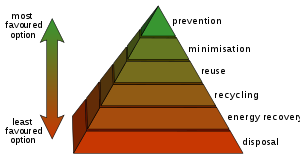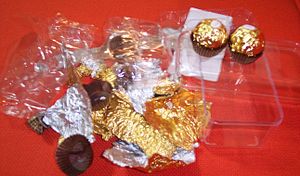| The waste hierarchy refers to the "3 Rs" reduce, reuse and recycle, which classify waste management strategies according to their desirability. The 3 Rs are meant to be a hierarchy, in order of importance. (Photo credit: Wikipedia) |
It’s amazing how much packaging it takes to ship something. Even something as simple as a book takes a box, shrink-wrap and something to fill the empty space between the box and the book - typically bubbles, foam peanuts or shredded paper. Where does all this packaging go once you’ve received your item? For most people it goes in the garbage - unless you're like me, and you save most of your packaging to use the next time you ship something (we'll talk more about reuse next week). And we haven’t even mentioned the packaging of food and items purchased locally in your every day shopping. Here are five ways to cut down on packaging and save resources.
#1. Buy in bulk. Whether you’re buying books online or cereal at your grocery, when you buy in bulk you cut down on packaging. Think about it - if you buy one book at a time online then you’re going to receive a box for each book and all the packaging that goes along with shipping that item. When you buy a regular box of cereal, you consume it and toss the box. However if you buy a bulk box of cereal it may last as long as three regular boxes of cereal - you get more cereal and less packaging.
#2. Buy from retailers who package using reusable or recyclable materials. And when you’re shopping, use reusable or recyclable containers. This trend is really catching on. Stand in any grocery store line and you’ll see people shopping with reusable shopping bags - that’s an example of cutting down on packaging because you’re not taking dozens of plastic shopping bags home. As a mail-order small business owner, I save packaging and reuse it for shipping items to our customers as much as possible. In fact, I haven't bought packing material (other than boxes) in almost 10 years!
Additionally, some retailers who manufacture and distribute processed foods are beginning to package them in reusable and/or easily recyclable containers to minimize landfill waste. And when it comes to books, why not go electronic and buy books with Kindle or another similar reader. You can even download e-books for free from some public libraries now! Not only will you reduce packaging, you'll also cut down on clutter from all those stacks of books that tend to accumulate around the house.
| Food Packaging (Photo credit: Wikipedia) |
#4. Buy used. Used products rarely come packaged. You just pick them up as is from the store. No packaging, no waste. And you can often save quite a bit of money as well.
#5. Barter and/or trade items rather than shopping. Bartering and trading for products is a great way to save money and conserve resources. Many people are forming book swap groups to save money and materials by simply sharing books. And some people are banding together to share clothing and other items. This can also be a fun way to connect with other like-minded individuals, which is important in helping you feel connected and supported in your community.
Packaging does more than fill landfills; it costs money and resources to produce - and even to recycle. When you take a few simple steps to cut down on packaging you’re having a significant effect on your environment. You’re making it a better place to live for you and for future generations.



No comments:
Post a Comment